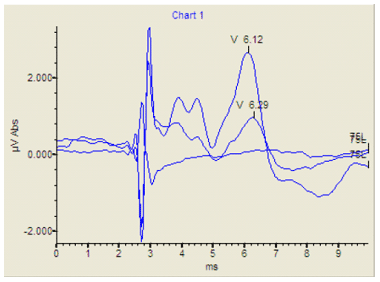Question
How to I setup for an Electrical Auditory Brainstem Response (EABR)?
Answer
Background
The Electrical Auditory Brainstem Response (EABR) is a measurement of the ABR using an electrical stimulus. The purpose of the test is to determine if the auditory nerve responds as expected to electrical stimulation. EABRs are reportedly used presurgically to determine if a cochlear implant should be attempted and postsurgically to determine if the cochlear implant is working properly. In clinical experience, however, there is little correlation between pre-operative measurements and post-operative fitting results. Some cochlear implant sites use the dynamic range of the EABR for fitting the cochlear implant processor with non-cooperative patients.
The Test Setup
The stimulus to elicit the response comes from the cochlear implant external stimulator. The cochlear implant software is where the stimulus and level are determined. The external stimulator sends a trigger to the GSI Audera to start acquiring data and initiates the stimulus. Because the EABR is symmetrical, the recordings are done with one channel only. The electrode montage for EABR testing includes an active electrode on the mastoid or earlobe of the contralateral ear to stimulation, a reference electrode on low forehead, and the ground electrode on the high forehead.
The Response
The EABR on the GSI Audera includes 1-2 msec of pre-stimulus recording, the electrical artifact of the external stimulator, then the ABR. The latency, amplitude and threshold can be measured. Typically, EABRs will have earlier latencies than a typical ABR. Some cochlear implant sites use the highest amplitude of the response as a measure of the MCL for fitting the cochlear implant.

This example shows three EABRs as the intensity of the cochlear implant software increases.
Protocol in the GSI Audera - AEP
External Trigger: Active (checked)
Transducer: N/A
Stimulus: N/A
Masking offset: N/A
Repetition Rate: 8.0 Hz
Polarity: N/A
Filters: 1 - 3K Hz
Time base = 0 to 15 msec
Noise rejection = 50 ±ìsec
For more information on methodology and
interpretation please refer to:
Firszt, J., Wackym, P., Gaggl, W., Burg, L., Reeder, R., (2003) "Electrically evoked auditory brainstem responses for lateral and medial placement of the Clarion HiFocus electrode" Ear & Hearing 24(2):184-190.
Kileny, PR., Zwolan, TA., Zimmerman-Phillips, Sl, Telian, S., (1994), "Electrically evoked auditory brain-stem response in pediatric patients with cochlear implants" Arch Otolaryngol Head Neck Surg, Oct 120(10):1083-1090.
Brown, C., Hughes, M., Lopez, S., Abbas, P. (1999) "Relationship between EABR Thresholds and Levels Used to Program the Clarion Speech Processor" Ann Oto Rhinol Laryngol 108(4): Part 2, suppl 177
Hodges, AV., Ruth, R., Lambert, P., Balkany, T. (1994) "Electric auditory brain-stem responses in nucleus multichannel cochlear implant users", Arch Otolaryngol Head Neck Surg Oct 120(10)
For more information on VIASYS, visit viasyshealthcare.com
Laura Voll is the Business Manger for GSI/VIASYS. She holds an M.A. in Audiology from the University of Wisconsin and has worked in the hearing industry for 15 years.